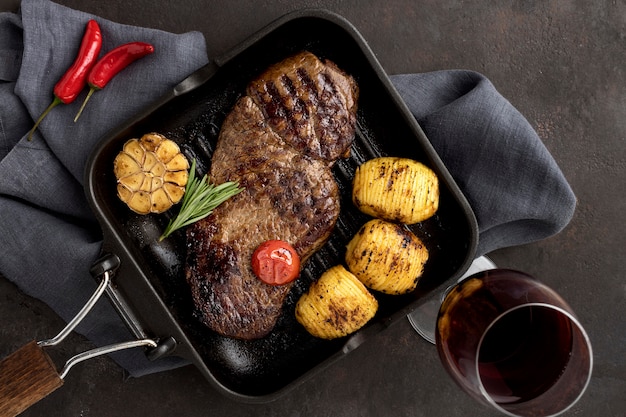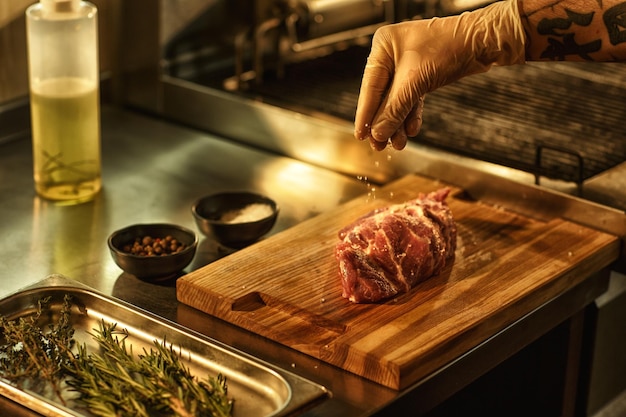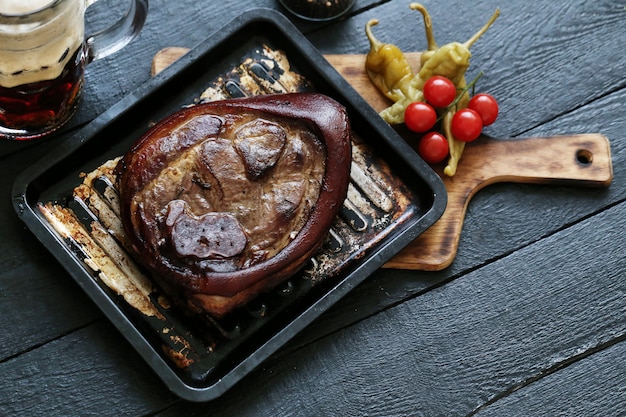Let's face it, there's nothing quite like a perfectly cooked ribeye steak. That juicy, tender, and flavorful cut of meat is a true culinary masterpiece. But let's be honest, sometimes those dreams of steak perfection turn into a bit of a culinary nightmare when the steak ends up overcooked and dry. Don't worry, my friend, I've been there too. We've all had those moments, but fear not, because I'm about to share my secrets to nailing a perfect ribeye every time.
This isn't just another boring recipe; it's a journey into the world of steak mastery. We'll explore the best cuts of meat, dive into the art of seasoning like a pro, unlock the secrets to achieving that beautiful sear, and master the art of achieving that perfect level of doneness. We'll even delve into some handy tips and tricks that will make your steak game stronger than ever. So, buckle up, and let's get started!
(Part 1) choosing the right ribeye

Finding the Perfect Cut
First things first, you need a good ribeye. Not just any ol' piece of meat will do. You want a cut that's got a good marbling, which is the fat that's interspersed throughout the muscle. This marbling is what gives the steak its flavour and tenderness. You'll find that the marbling is often graded with words like "select," "choice," and "prime" with prime being the most marbled and thus the most flavorful. Now, I'm a big fan of a thick-cut ribeye, at least 1 inch thick. It allows for a nice, even sear on the outside, while keeping the inside juicy and pink. And let's be honest, it just looks more impressive, right?
The Bone-In Debate
Some folks swear by bone-in ribeyes, saying the bone adds flavour. And you know what? They're not wrong. The bone does add a little something extra. The bone acts like a natural insulator, helping to keep the meat moist and warm during cooking. It also provides a delicious, flavorful crust that adds another layer of complexity to the overall taste. But personally, I find that boneless ribeyes are easier to cook and more versatile. Plus, they're often a bit more affordable. Ultimately, it's down to personal preference.
(Part 2) Seasoning Secrets

The Salt Game
Okay, let's talk about seasoning. I'm a big believer in keeping it simple. You don't need a million fancy spices to make a great steak. Salt is your best friend here. I use kosher salt because the crystals are larger and they don't absorb into the meat as quickly, which means you get a nice even seasoning. Now, the timing is key. Salt your steak at least 30 minutes before cooking, but ideally, 1 to 2 hours before. This lets the salt draw out moisture and then reabsorb it, making the meat more flavorful and tender.
Black Pepper Power
Freshly ground black pepper is a must. I like to use a coarse grind, as it adds a nice bite. Season with pepper just before cooking. Remember, we're not trying to bury the flavour of the beef, just enhance it.
Beyond the Basics
While salt and pepper are the foundation of any good steak seasoning, you can certainly experiment with other flavors. A pinch of garlic powder, onion powder, or a sprinkle of smoked paprika can add depth and complexity to your ribeye. Just remember to keep it subtle and avoid overwhelming the natural flavor of the beef.
(Part 3) Stovetop Searing

Prepping Your Pan
Right, let's get the stovetop hot. You want your pan to be smoking hot, like it's ready to party. I use a cast iron skillet, but a heavy-bottomed stainless steel pan will also do the trick. Heat the pan over high heat, then add a tablespoon or two of oil. I prefer grapeseed or avocado oil because they have a high smoke point, meaning they won't burn as easily.
The Art of the Sear
Once the oil is shimmering, carefully place your steak in the pan. You'll hear that beautiful sizzle, and that's the music to our ears. Now, don't move the steak for at least 2 minutes. Let it get a nice, crispy sear on the first side. This is how you lock in the juices and develop that delicious crust. After 2 minutes, give the steak a gentle nudge to make sure it's not sticking. Then, flip it and repeat the process on the other side.
Side Show Time
Now, you can add some aromatics to the pan for extra flavour. I like to throw in a few sprigs of rosemary and a couple of cloves of garlic. But again, it's all about personal preference. Don't forget to flip the steak every couple of minutes to ensure even cooking.
(Part 4) Finishing Touches
The Flipping Game
You might be thinking, "How do I know when it's done?" Well, my friend, that's where the flipping game comes in. We're aiming for a perfect medium-rare, which means a nice pink center and a juicy bite. But don't worry, I'll give you a few tricks to ensure success. First, you can use a meat thermometer. Insert it into the thickest part of the steak, avoiding the bone. For medium-rare, you want the temperature to be around 130°F.
Time for a Break
Once you're happy with the sear, it's time to give the steak a little break. Transfer it to a cutting board and let it rest for 5 to 10 minutes. This allows the juices to redistribute throughout the steak, resulting in a more tender and juicy bite.
Butter Basted Bliss
For an extra touch of decadence, you can baste your steak with butter during the last few minutes of cooking. Simply melt a tablespoon or two of butter in the pan and spoon it over the steak. This not only adds flavor but also creates a beautiful, glossy finish.
(Part 5) Serving Up Perfection
The Presentation
Now, it's time to show off your culinary skills. I like to slice my ribeye against the grain, which means cutting across the muscle fibers. This makes the steak easier to chew and helps to release even more of those delicious juices.
Sidekick Stars
No steak is complete without a proper sidekick. I'm a sucker for roasted vegetables, like asparagus or Brussels sprouts. But you can also go for mashed potatoes, creamy polenta, or a classic green salad. A rich and flavorful red wine sauce or a tangy chimichurri sauce can also elevate your steak to new heights.
(Part 6) The Art of Patience
The Wait is Worth it
Okay, so you've got your perfectly seared ribeye, it's resting beautifully, and the sides are ready to go. But before you dive in, resist the urge to cut into it straight away. Patience, my friend, patience. Let those juices settle and redistribute, giving you the most delicious, tender, and flavorful bite.
(Part 7) Tips and Tricks
Temperature Matters
When you're working with a good quality ribeye, you want to make sure you're starting with the right temperature. Take the steak out of the fridge at least 30 minutes before cooking, allowing it to come to room temperature. This ensures that it cooks evenly and doesn't end up cold in the middle.
Don't Be Afraid of the Fat
Remember that marbling we talked about? Well, that fat is your friend. It adds flavour and tenderness, so don't trim it all off. Just try to trim any excess fat that's not going to render properly during cooking.
Rest Your Arms
We all get a little overzealous with the flipping. But remember, the more you touch the steak, the more likely it is to lose moisture. Keep those flips to a minimum and let the steak cook undisturbed.
The Power of Resting
The resting period is not just about letting the juices redistribute, it's also about allowing the internal temperature of the steak to stabilize. This ensures that the meat cooks evenly throughout and prevents it from becoming overcooked.
(Part 8) FAQs
Q: Can I use any type of oil for searing?
A: While any oil will work, I recommend using oils with a high smoke point, like grapeseed, avocado, or peanut oil. These oils can withstand the high heat of searing without burning. Olive oil, while delicious, has a lower smoke point and can quickly burn, ruining the flavor of your steak.
Q: What if my steak is too thin?
A: If your steak is less than an inch thick, you might want to consider cooking it on the stovetop for a shorter amount of time and finishing it in the oven. This will help to ensure that the inside of the steak cooks evenly without overcooking the outside.
Q: How can I make sure my steak is cooked to my liking?
A: Use a meat thermometer! It's the most accurate way to check for doneness. If you don't have one, you can use the finger-press method, but it's not as reliable. Here's how it works: Touch your steak and compare the firmness to different parts of your hand. The tip of your index finger is about as firm as a rare steak, the middle of your palm is like medium-rare, and your thumb is like well-done.
Q: What can I do with the leftover steak?
A: Leftover steak is a blessing in disguise. Slice it up and add it to salads, sandwiches, or use it to make a delicious steak and cheese panini. You can also use it to create a flavorful steak hash or a hearty stew.
Q: Any tips for making my steak extra special?
A: You can add a finishing touch to your ribeye by topping it with a pat of butter or a drizzle of olive oil. Or, if you're feeling fancy, try adding a sprinkle of herbs or a few slices of truffle.
(Part 9) The Bottom Line
Okay, so you've made it to the end of this journey, and I hope you're feeling confident. Remember, the key to a perfect stovetop ribeye is using the right cut, seasoning it well, searing it properly, and letting it rest. With a little practice, you'll be turning out restaurant-quality steaks in no time. So, what are you waiting for? Go forth and conquer that ribeye! And if you need any more advice, just give me a shout. Happy cooking!
(Part 10) Beyond the Basic Recipe
Now that you've got the basics down, let's explore some exciting variations to take your steak game to the next level.
Steakhouse-Style Ribeye
For a truly decadent experience, try adding a touch of steakhouse flair to your ribeye. After searing the steak, place it on a baking sheet and transfer it to a preheated oven at 350°F (175°C). Cook for 5-7 minutes for medium-rare, or longer for your desired level of doneness. While the steak is in the oven, make a simple pan sauce in the cast iron skillet. Deglaze the pan with a splash of red wine or beef broth and add a tablespoon of butter, stirring until the sauce is smooth and glossy. Spoon the sauce over your steak for a restaurant-worthy presentation.
Spiced Up Ribeye
For a touch of spice, create a flavorful rub using your favorite spices. Combine paprika, garlic powder, onion powder, cumin, chili powder, and a pinch of cayenne pepper. Rub the spice blend generously all over the steak and let it sit at room temperature for at least 30 minutes before searing. The spice rub will add a delicious kick to your ribeye and create a beautiful crust.
Herb-Infused Ribeye
For a more delicate and aromatic flavor, try infusing your ribeye with fresh herbs. Finely chop your favorite herbs, such as rosemary, thyme, or oregano. Combine them with a little olive oil and salt, and rub the mixture all over the steak. Let it marinate for at least 30 minutes, allowing the herbs to infuse their flavor into the meat.
(Part 11) Steak and SidesClassic steak sides
Here are some classic sides that pair perfectly with a perfectly cooked ribeye:
Mashed Potatoes: Creamy and comforting, mashed potatoes are a classic steak companion.
Roasted Vegetables: roasted asparagus, Brussels sprouts, or carrots add a beautiful pop of color and flavor to your plate.
Green Salad: A simple green salad with a light vinaigrette helps to balance out the richness of the steak.
Creative Steak Sides
For those who want to venture beyond the traditional, here are some creative side dishes that complement the steak beautifully:
Polenta: Creamy polenta with a sprinkle of parmesan cheese is a delicious and satisfying accompaniment.
Mac and Cheese: A creamy and cheesy mac and cheese adds a touch of indulgence to your steak dinner.
Mushroom Risotto: A rich and flavorful mushroom risotto is a sophisticated and elegant choice.
(Part 12) Wine Pairing
No steak dinner is complete without a perfect wine pairing. Here are some suggestions for wines that complement the rich and savory flavors of a ribeye:
Cabernet Sauvignon: A classic pairing with a full-bodied red wine with notes of black fruit, spice, and oak.
Merlot: A softer and smoother red wine with notes of cherry, plum, and vanilla.
Zinfandel: A fruit-forward red wine with notes of blackberry, raspberry, and spice.
Syrah/Shiraz: A robust red wine with notes of black pepper, dark fruit, and leather.
(Part 13) Final Thoughts
There you have it, my friends, the ultimate guide to perfect stovetop ribeye steak. Now, go forth, embrace your inner chef, and unleash your culinary creativity. Remember, the journey to steak mastery is a delicious and rewarding one. And if you ever need a little guidance along the way, just give me a shout. Happy cooking!
Everyone is watching

Perfect Rice Every Time: The Ultimate Guide to Cooking Rice
Cooking TipsAs a self-proclaimed foodie, I've always been a bit obsessed with rice. It's the foundation of countless cuisi...

Prime Rib Roast Cooking Time Chart: Per Pound Guide
Cooking TipsPrime rib roast. Just the name conjures images of lavish dinners, crackling fires, and hearty laughter. It’s ...

The Ultimate Guide to Cooking Asparagus: Tips, Techniques, and Recipes
Cooking TipsAsparagus. The mere mention of this spring delicacy conjures up images of vibrant green spears, crisp and burs...

Ultimate Guide to Cooking the Perfect Thanksgiving Turkey
Cooking TipsThanksgiving. Just the word conjures up images of overflowing tables laden with delicious food, the scent of r...

How Long to Bake Potatoes in the Oven (Perfect Every Time)
Cooking TipsBaked potatoes are a staple in my kitchen. They're incredibly versatile, delicious, and surprisingly easy to m...
